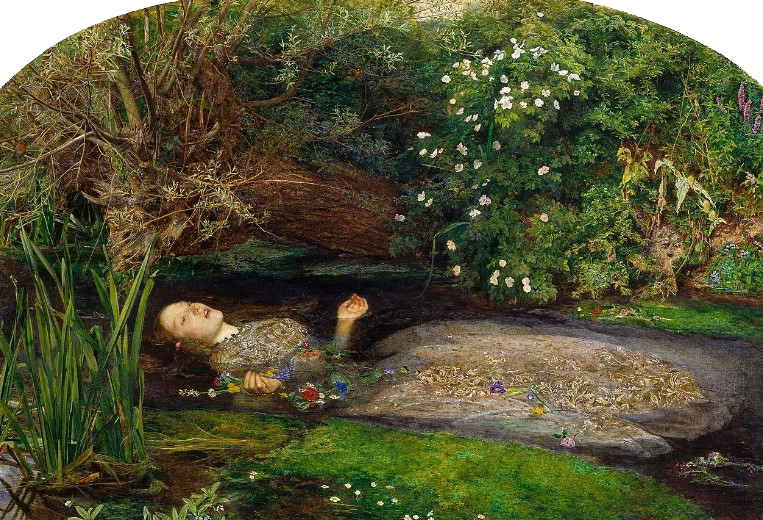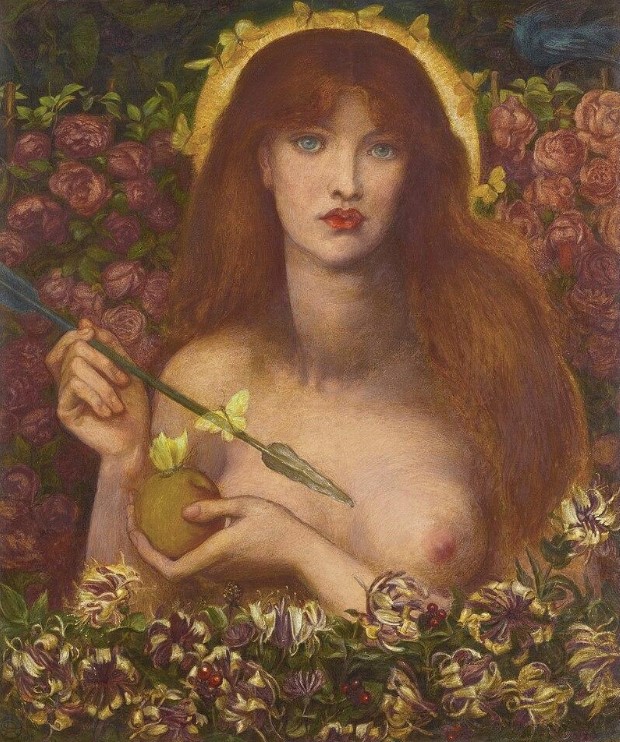Women in preraphaelite art;
the feminine mysticism that comes alive
Article written by:
ALEKSANDRA ILIC
January, 2025
In history and in art there’s always been a connection between the feminine and the mystic, leading the two topics to intertwine with each other and provide models of expression for various artistic currents including Impressionism, Romanticism, and Art Nouveau.
The Preraphaelite Brotherhood (shortened to PRB) was formed in September, 1848 in Great Britain thanks to a group of young anticonformists like William Holman Hunt, Gabriel Dante Rossetti and John Everett Millais.
William Michael Rossetti, Thomas Woolner, James Collinson, Frederic George Stephens and others would join the brotherhood after an invitation from the three funding members.
The members of the Brotherhood were painters, poets and sculptors who disdained the dull art of the Royal Academy and the stern and puritan canons established by the Victorian period.
They aimed at the return of a nostalgic past, a nearly magical one where art came together with beauty and life, a calling back to chivalric, biblical , divine and dantesque themes.
The protagonists of the paintings become women of poor backgrounds; they impersonate gods, warriors and maidens from worldwide literature, becoming immortalized in international pieces like Millais’s Ophelia and Gabriel Dante Rossetti’s Venus Verticordia and Sea-Spell.
The name “preraphaelite” stems from the admiration of the artists towards the art that was made before its “contamination” by painter Raffaello Sanzio in High Renaissance preferring art before his arrival, the one observed in the First Renaissance characterized by the simplicity and reality of nature, instead of the one promoted by the Royal Academy which appreciated a more auster, classical, elegant and artificial look.
Academic art or Academism was born in the middle of the ‘800, flourishing in France.
It was often an object of controversy among the people of the time since many believed that the art produced was painted in a masterful manner but devoid of life, making human subjects look more like objects because of how perfectly they were depicted.
Academic art had other names like Art Pompier; it isn’t certain where the term originates from but it is believed that it’s a call back to the similarities with the ancient helms with the ones used by the firefighters in that period.

Ophelia by John Everett Millais 1851-1852
Tate Britain
In preraphaelite art we observe female subjects with expressive gazes adorned by red or black hair that frame their pensive visages, a bit detached from the world around them.
Their bodies are never caged or made stiff by victorian clothes; preraphaelite artists were convinced that the female body was beautiful in its natural form so it was useless to hide it behind corsets and heavy clothing.
The fact that a lot of paintings portrait women with red hair is another anticomformist act of the brotherhood; a lot of women with crimson hair were associated with witchcraft and sinful desire; these superstitions were still spread in the victorian era. One of the most famous women to pose for the brotherhood was Elizabeth Eleanor Siddall -known after her wedding with Gabriel Dante Rossetti as Elizabeth Siddal – a model, poet and artist.
Famous paintings by her were her self-portrait of 1857 and The Haunted Wood of 1856. Found in a shop at Cranbourne Alley by Walter Howell Deverell (artist that made A Pet, the mock marriage of Orlando and Rosalin) she was introduced to the brotherhood and became one of the main muses.
The first poem of the three presented at the end of the page takes inspiration from the Ophelia of John Everett Millais; painted in a two-year period (1851-1852). The model is the cited above Elizabeth Eleanor Siddall.
The woman remained immersed in a bathtub full of cold water even when one of the lamps that was supposed to keep her warm broke.
Siddal came down with bronchitis which will mark the downfall of her health, and culminate in her death at the age of thirty-two because of suicide after taking a lot of laudanum.
A call-back to the tragic end of the character for which she posed, the subject of the painting being the shakespearian character of Ophelia of Hamlet, the sweet daughter of Polonius and the object of longing of the men and Hamlet in the tragedy.
The maiden starts to fall into depression after Hamlet reproaches her love and becomes mad after she discovers that Hamlet assassinated her father, Polonius.
Ophelia’s death isn’t shown, rather it is described by her mother Gertrude to Laerte, brother of hers:
The woman explains the death of the girl; Ophelia went to pick bouquet of flowers to become more beautiful, but didn’t notice a fallen branch of a willow that makes her fall in a river where she meets her untimely death.
The poem Rest in thy bed, Sweet Ophelia aims to let the spirit of the maiden rest in an eternal slumber, away from the lustful gazes of men and the violences suffered in life, recalling bucolic landscapes and fairy creatures present in other shakespearian works.

A Sea-Spell by Gabriel Dante Rossetti 1877
Harvard Art Museums in Cambridge, Massachusetts.
The second composition is an ode to the painting of Gabriel Dante Rossetti, Sea-spell painted in the 1877: the model of this painting is Alexa Wilding, one of the most loved muses by Rossetti.
It represents a beautiful siren focused on plucking the strings of an instrument, charming sailors unfortunate enough to hear her.
Even if Rossetti accompanied his paintings with his own poems to better express the subjects of his art that shouldn’t stop the reader from taking inspiration from his work and make something diverse and unique from it for Art itself is the muse of the soul.
The poem Love is a Lady that sings with doves takes inspiration both from Sea-spell and the Greek Goddess Aphrodite that inspires feelings of sweetness and joy.
Other symbols of the goddess are myrtle, doves and pearls which recall the birth of the beautiful deity and are reflected in the melodic verses.
If feelings of affection and tenderness are incorporated in Love is a Lady that sings with doves, the third and last poem, Scarlet is the shade of thy gaze, shows more of a carnal and passionate side of the roman goddess that intersects with the greek Aphrodite; Venus.

Venus Verticordia by Gabriel Dante Rossetti – watercolor – 1868
This painting’s version was bought december, 10 2014 at Sotheby’s for € 3.648.084.
In the last painting of Rossetti, the Venus Verticordia or Venus that changes hearts, we observe the only nude of the art of Gabriel Dante Rossetti and the transition from the image of the pure and chaste woman seen in other of his works to a true femme fatale. The poem is an ode and a warning to certain feelings that change in time, assuming more sexual facets instead of simple affection of that felt in pre-adolescence.
A warning because irrational passion can bring destruction to the spirit, like what happened to the city of Troy, destroyed by Paris and his carnal desires for the beautiful Helen of Sparta.
WEBOGRAPHY
https://en.wikipedia.org/wiki/Venus_Verticordia_(Rossetti)
https://www.britannica.com/art/Pre-Raphaelite-Brotherhood
https://www.artandobject.com/articles/women-pre-raphaelite-art
https://artsandculture.google.com/asset/a-sea-spell/jQFtojPdjp6GUg
https://en.wikipedia.org/wiki/A_Sea-Spell
https://it.wikipedia.org/wiki/Arte_accademica
https://en.wikipedia.org/wiki/Elizabeth_Siddal
https://it.wikipedia.org/wiki/Elizabeth_Siddal
https://it.wikipedia.org/wiki/Alexa_Wilding
https://it.wikipedia.org/wiki/Ophelia_(Millais)
https://it.wikipedia.org/wiki/Walter_Howell_Deverell
https://en.wikipedia.org/wiki/Walter_Deverell
https://www.ilsensodelbello.it/sensuale-e-casta-la-venere-verticordia-di-dante-gabriel-rossetti/
https://www.tate.org.uk/art/art-terms/p/pre-raphaelite/why-were-pre-raphaelites-so-shocking
https://rehs.com/eng/2024/06/the-pre-raphaelites-victorian-counterculture/
https://vitadamuseo.wordpress.com/2015/10/30/la-donna-perduta-e-il-lato-oscuro-della-societa-vittoriana/
https://www.missdarcy.it/la-fallen-woman-in-epoca-vittoriana-nella-letteratura-e-nellarte#:~:text=La%20fallen%20woman%2C%20la%20donna,fa%20sesso%20fuori%20dal%20matrimonio
https://www.lezionidarte.it/elisabeth-siddal-la-donna-preraffaellita/
https://ruthmillington.co.uk/why-are-they-called-the-pre-raphaelites/
https://appuntidistoriadellarte.it/Pompier.html
https://mostremuseisandomenico.it/preraffaelliti/la-nascita-della-pre-raphaelite-brotherhood-prb/#:~:text=La%20Confraternita%20dei%20Preraffaelliti%20
https://www.theoi.com/Olympios/Aphrodite.html
https://en.wikipedia.org/wiki/Venus_Verticordia
Rest in thy bed, Sweet Ophelia
Scarlet is the shade of thy gaze
What darkness overshadowed
thy soul, sweet Ophelia
that thou now rest at the bottom
of that stream full of despair?
What horrors have thine emerald eyes
witnessed to break the heartstrings
of thy young innocent heart?
Maiden of fragile mind
scapegoat of the Silver Fates
how many doomed titles
shall thy person bear?
Chaste girl, let’s weave a dream
before the arrival of the nightmare
where fairies of yore, spirits of the earth
spin golden threads in thine braids
red as the crimson sun when it sets.
Run Ophelia in the open fields!
thy laughter bearing resemblance to
the first honey of the verdant spring.
Here thou shan’t face untrue love
Here thou shan’t face spilled blood
of thine own.
Weave flower crowns of daisies, violets, and roses,
and forget-me-nots and whatever thy heart yearns for.
Pure girl, let’s weave a symphony
before the start of the requiem
where mischievous imps, elves from mists
decorate thy swan-like gowns
with obsidians, amethysts and quartzes abound.
Dance Ophelia in the starlit meadows!
thy festive cries spurring joy
among the noble ancient folk.
Here thou shan’t be commanded
Here thou shan’t be the object
of unwanted attention.
Arrange flower bouquets of orchids, and mead wort, and pheasant’s eye,
and poppies and whatever thy spirit aches for.
Rest in thy bed, Sweet Ophelia.
A lullaby of woe
the old willow sings
and thou shall forever live
in the comfort of an infinite dream.
ALEKSANDRA ILIC
December, 2024
Thou think the heart to be unshaken
to the rises and falls of the nectar called love
but lo and behold thine eyes hide affections
that have already faded into something
no longer innocent, nor chaste, nor pure.
A fragment of time to realize thy chest
bears a faint golden light spurred from the arrow
that Cupid himself from his quiver gave to Her
arousing novel feelings deep within thy soul
while She laughs pleased by Herself.
Scarlet is the shade of thy gaze,
dear delighted mortal child.
Thy shyness already forgotten
lost in some corner of thy youth
never to be found again.
Thou has been changed
from a pure lily to crimson bloom
a fervent blessing or chaotic blasphemy
hidden in disguise for thee to find out.
Like Pandora’s box open out of curiosity
isn’t it a serenade to the unknown
to make those strange, passionate feelings
thine?
No need to abstain from the aureate ambrosia
that covers thee sweetly, drenching thee in flavours
only known to flourishing adulthood.
Scarlet is the shade of thy gaze,
no reason nor rationality
behind those eyes roaming
all over the objects of thy passions.
Touching and kissing and nibbling pale, strong hands.
Tracing shapes and valleys before unseen.
Goodbye innocence, for thee shan’t be missed
when Love and Lust are such boisterous companions!
Oh, very pleased is She by Her work when Aurora starts to rise
letting her rest in fields of honeysuckle sweet and pink blossoms
a lone pome of golden sheen sitting on her tender palm
reflecting a naive youth and forgotten tales of yore
of tall walls once dear to the Sun consumed by the same passions
thou are now happily prisoner of.
ALEKSANDRA ILIC
December, 2024
Love is a lady that sings with doves
Love is a lady that sings with doves
clothing herself in veils of myrth;
brilliant eyes of mother of pearl
grace this wretched wicked world.
String after string plucked
beneath her rose tainted fingers
laces melody after melody
of crystal clear yearnings.
Love is a lady that sings with doves
no one under her solemn gaze
shall feel the spirit ache;
the delicate heart despair.
For what is an existence
devoid of love and loving;
infertile soil deprived
of wanders and wondering.
Love is a lady that sings with doves
she’ll sing and hum and cry
‘till the end of times arrives
for Love is mother to all
and all returns to her,
the Lady that sings with doves.
ALEKSANDRA ILIC
December, 2024